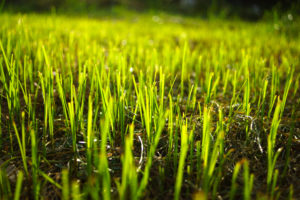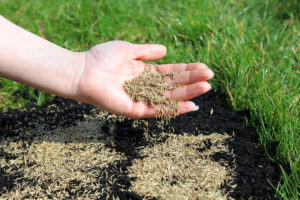We’ve all seen them: those ugly brown spots in your yard where the grass has withered and died. They’re particularly noticeable this time of year in Indiana due to the long, hot days and lack of rain—and unfortunately, rejuvenating them with new grass is a little more complicated than just tossing around a few handfuls of seed.
The good news is that healthy, new grass isn’t difficult to grow if you pay attention to a few key factors. Here are the four most important things to keep in mind:

Timing. The most ideal season to establish new turf is late summer. During this time of year, ample rain helps ensure seeds can quickly take root and grow, and so long as you plant before October, your grass should have plenty of time to get established before winter.
The window between October and Thanksgiving isn’t the best time to plant new grass. Chances are good it won’t become strong enough to make it through the winter since the root systems will not be well developed. However, you can plant grass seed after Thanksgiving—a process called dormant seeding—where your seeds will germinate in early spring due to the heavy moisture in the soil.
It’s also ok to plant new grass during spring months, but many weed control products used during this time of year will also harm new turf. This might make it tricky to coordinate a landscape maintenance plan, so just make sure you’re paying attention to your turf treatments.
Grass selection. Choosing the right blend of grass seed is important for aesthetic reasons. Here in Indiana, most turf is made up of blue and perennial rye grasses, so you want to match these varieties to ensure a uniform appearance for your lawn. Tall fescue is another variety we see occasionally in Indiana, so make sure to identify the kinds of grass in your yard before buying seed.
Like most things, quality comes with a price when it comes to grass seed. Typically, if a bag of seed is more expensive, it will be purer and produce healthier, thicker grass. We recommend spending a little bit extra on premium seed, because in the long run, the high quality of the grass it produces will save you money since you probably won’t need to replace it for many years.
Seeding rate. When spreading new seed over old growth in your yard, you’re doing what’s called overseeding—this is just a shorter way of saying over-the-top seeding. Doing it correctly means spreading the right amount of seed over a given area. The formula for this is simple: You want to use between three and four pounds of seed per 1,000 square feet.

If you aren’t overseeding a big area, spreading seed by hand will work—just make sure you’re distributing it as evenly as possible. If you have a larger area or just want to make sure your seed spreading is very even, you can get a seed spreader from just about any hardware store.
Overseeding alone is not going to be the answer for very large, bare areas. In these cases, you’ll want to till the land, prepare a good seed bed, spread the seed, rake it in, and then possibly mulch the area with straw. When doing this process, you can spread seed using that same formula of three to four pounds of seed per 1,000 square feet.
Two other things you might want to think about to improve your results are soil aeration and fertilizer. Aerating your soil should be done once a year and will help your entire lawn thrive while encouraging healthy new growth, because it filters water and nutrients into the soil. Spreading fertilizer once your seed is down is also one more way to help your grass grow even stronger.
Watering. How you water your new grass is the most critical part of this whole process, and one of the most common mistakes we see is not enough hydration for new growth. The first two to three weeks are the most important, and during this period, you should be watering every day that there isn’t rain. The key is to water lightly, so your soil stays moist but isn’t drenched. Once growth is firmly established after a few weeks, you can water less frequently but more deeply as the young turf needs lots of hydration for vigorous growth.
Growing new grass doesn’t have to be difficult, but it does take a bit of specialized knowledge and attention to detail to get it right. By following the tips above, you can give your new grass a strong start—and help ensure it’ll stay lush and healthy for many years to come.
At Engledow, we specialize in working with all things green and growing. If you’re looking for help taking care of your landscape, want to design and build new hardscaping features—or if you need assistance planning your next big event—we’d love to have a conversation.

